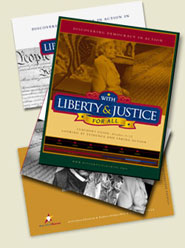With Liberty & Justice for All
Related Curriculum Standards and Benchmarks
9th-12th Grades—Looking At Evidence and Taking Sides National Curriculum Standards for Social Studies Strands I, II, V, VI, X National Standards for the English Language Arts 1, 4, 7 Social Studies
C-1.1.1 Identify roles citizens play in civic and private life, with emphasis on leadership
C-1.1.4 Explain the purposes of politics, why people engage in the political process and what the political process can achieve.
C-2.1.4 Explain challenges and modifications to American constitutional government as a result of significant historical events such as the American Revolution, the Civil War, expansion of suffrage, the Great Depression and the civil rights movement.
C-2.2.2 Explain and evaluate how Americans, either through individual or collective actions, use constitutional principals and fundamental values to narrow gaps between American ideals and reality with respect to minorities, women, and the disadvantaged.
C-2.2.3 Use past and present policies to analyze conflicts that arise in society due to competing constitutional principals or fundamental values (e.g. liberty and authority, justice and equality, individual rights, and the common good).
C-6.2.8 Describe various forms and functions of political leadership and evaluate the characteristics of an effective leader.
C-6.2.5 Describe how citizen movements seeks to realize fundamental values and principals of American constitutional democracy. USHG 6.3.3 Analyze the successes and failures of efforts to expand women's rights, including the work of important leaders.
Language Arts
CE 1.3.7 Participate collaboratively and productively in groups- fulfilling goals and responsibilities, posing relevant questions, giving and following instructions, acknowledging and building on ideas and contributions of others to answer questions or to solve problems, and offering dissent courteously.
CE 1.4.4 Interpret, synthesize and evaluate information/findings in various print sources and media (e.g. fact and opinion, comprehensiveness of the evidence, bias, varied perspectives, motives and credibility of the author, date of publication) to draw conclusions and implications.
CE 3.1.5 Comparatively analyze two or more literary or expository texts, comparing how and why similar themes are treated differently, by different authors, in different types of text, in different historical periods, and/or from different cultural perspectives.
CE 3.1.10 Demonstrate an understanding of the connections between literary and expository works, themes, and historical and contemporary contexts.
|  |









